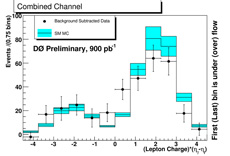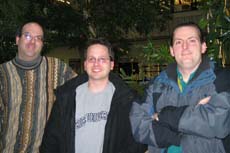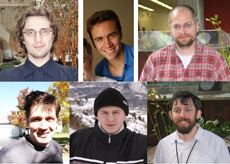|
Thurs., December 14
12:00 p.m. Special Particle Astrophysics Seminar - The Dark Side (WH-6W) (NOTE DATE, TIME, LOCATION)
Speaker: D. Stojkovic, Case Western Reserve University
Title: Black Hole Formation, Evaporation and the
Information Loss Paradox
1:00 p.m. ALCPG ILC Physics and Detector Seminar - Hornets Nest (WH-8XO)
Speaker: R. Raja, Fermilab
Title: The MIPP Experiment Upgrade and Hadronic
Shower Simulations
2:30 p.m. Theoretical Physics Seminar - Curia II
Speaker: G. Kozlov, JINR, Dubna
Title: Lepton-Flavor Violation, Extra Gauge Bosons and
New Physics Scale
3:30 p.m. Director's Coffee Break - 2nd Floor Crossover
4:00 p.m. Accelerator Physics and Technology Seminar - 1 West
Speaker: P. Adamson, University College, London/Fermilab
Title: Main Injector Digital Dampers
6:00 p.m. UTeV Seminar - 1 West
Speaker: R. Field, University of Florida
Title: Toward an Understanding of Hadron-Hadron Collisions:
From Feynman-Field to the Tevatron
Fri., December 15
11:00 a.m. Computing Techniques Seminar
- FCC 1
Speaker: V. Welch, University of Illinois, Urbana-Champaign
Title: A Roadmap to Federated Identity for Grids
2:30 p.m. Special Particle Astrophysics Seminar (NOTE DATE ) -
Curia II
Speaker: P. Wu, National Taiwan University
Title: First Results from MAXIPOL and Status of AMiBA
3:30 p.m. Director's Coffee Break - 2nd floor crossover
4:00 Joint Experimental Theoretical Physics Seminar -
1 West
Speaker: A. Gritsan, Johns Hopkins University
Title: Measurement of Alpha: Taming the Mischievous Penguin
Click here for NALCAL,
a weekly calendar with links to additional information. |
Thursday, December 14
-Minnesota Wild Rice with Chicken
-Tuna Melt on Nine Grain
-BBQ Ribs
-Chicken Casserole
-Buffalo Chicken Wrap
-Assorted Slice Pizza
-Toasted Pecan Chicken Salad
Wilson Hall Cafe Menu |
|
Thursday, December 14
Dinner
Coquille St. Jacque
Medallions of Pork Tenderloin
with Port Mushroom Sauce
Corn Risotto
Vegetable of the Season
Chocolate Fondue with Assortment of Fruit
Wednesday, December 20
Lunch
Salmon and Spinach Wellington
Mixed Greens with Radishes
and Raspberry Vinaigrette
Chocolate Cake with Raspberry Sauce
Chez Leon Menu
Call x4598 to make your reservation. |
|
|
The new kid is moving fast

Hideyuki Takei helped to install the scintillator in SciBar last week.
Fermilab's wily little experiment SciBooNE passed a major milestone last week. One of its three components--the part of the detector known as "SciBar"--had its scintillator installed without any hitches and ahead of schedule. "It was supposed to take about twelve days," said team member Hideyuki Takei. "We finished in about nine."
SciBooNE is a neutrino detector that will inhabit a 23-by-16-foot pit about 300-feet downstream of the neutrino beam source, powered by the booster accelerator. The detector will have three parts:
SciBar: A plaid of horizontal and vertical scintillator strips, SciBar determines the location in which a neutrino hits the detector. When SciBar interacts with an incoming neutrino, it turns the neutrino into a muon (the electron's heavy-set cousin) and a proton.
The proton gets caught in SciBar, but the muon makes it to the next step, the Electron Catcher. The EC measures photons and electrons that may have been produced with the proton and the muon. Like a bowling ball rolling through a pile of ping-pong balls, the muon easily filters through the electrons and photons that get knocked into the EC.
The Muon Range Detector is the next stop for the muon. Layers of steel slow it down, and scintillator in between detect its presence. Knowing how many layers of steel the muon has traversed reveals how much energy the muon started with. Adding the muon's energy to the proton's energy gives the energy of the original neutrino that slammed into SciBar.
The SciBooNE experiment may be up and running as soon as April. Just a year ago, the team was dismantling SciBar at KEK in Japan to be shipped over to Fermilab for re-use. Now they are arranging the detector inside a white masking-tape outline set to the dimensions of SciBooNE's tiny, final resting place. "Installation in the SciBooNE enclosure will be like a 3-D version of Tetris," said SciBooNE Project Head Rick Tesarek.
--Siri Steiner
More about SciBOONE:
|
Comma economy?
Dear FT:
I can't help but to notice the missing commas in the last two issues of Fermilab Today. Two were omitted yesterday, and one was omitted today. I understand that with the federal budget process on hold, many cutbacks have to be made. Fortunately, however, I happen to have some commas retrieved from some recycled BTeV design reports and have included them for your future use.
, ,,, ,,, , , , , ,
Cheers,
Dave Pushka
PPD, Mechanical Engineering
Editor Responds:
Thanks for the extra commas, Dave. They can be slippery little buggers.
|
Bringing arts and
humanities into the grid
 Image from a virtual gallery created with the CITRIS Collaborative Gallery Builder, a project associated with HASTAC.
Image Courtesy CITRIS/University of California
Image from a virtual gallery created with the CITRIS Collaborative Gallery Builder, a project associated with HASTAC.
Image Courtesy CITRIS/University of California
Since 2003, the HASTAC consortium has worked toward the novel objective of developing software and hardware solutions for the worlds of the arts and humanities. HASTAC - which stands for Humanities, Arts, Science and Technology Advanced Collaboratory - also advocates the inclusion of thought on the social, ethical and access issues of technology in parallel with its creation.
"The idea was for humanities professors to look at ways to incorporate technologies like grid computing into their research," says HASTAC Project Leader Jonathan Tarr. "They needed to save humanities from becoming a group of scholars who only work on physical text and weren't going along with the technology revolution."
Read More |
Chicago Tribune,
December 9, 2006:
Isotope project back on track
Argonne gears up to prepare its case
The federal government is reviving plans to build a $500 million rare isotope accelerator that scientists at the University of Chicago and Argonne National Laboratory hope to bring to Illinois.
A report released Friday by the influential National Academies of Science supports the notion and a task force organized by the government met in Chicago Friday to discuss how such a project might proceed.
"The real news today is that a project everyone thought was dead is really back on track again," said Michael Turner, Argonne chief scientist. "Argonne will prepare a great case for building the facility here."
Read More |
|
|
From ancient Greece
to the Tevatron

The difference in angular distributions of photons and lepton from W boson decays.*
A common thread has been connecting theories of nature for nearly 2500 years. Ancient Greeks believed all matter could be broken down into four "roots": water, earth, air and fire. These roots were bound by the forces of love and hate, together creating unity and division. In this rather romantic theory, all features of nature are determined by the mixing of these basic elements by the two forces. Today, physicists embrace a theory called the Standard Model, which forms a description of the universe with matter particles (quarks and leptons) bound or repelled by the efforts of force-carriers (photons, gluons, W/Z bosons). Although it is the more modern of the two theories, the Standard Model is not entirely devoid of the passionate relationships envisioned by the Greeks.
The Standard Model predicts a relationship between two force-carriers, the photon and the W boson, that exhibits both harmony and discord. When produced together, the angular distribution of the photon should present regions of both enhancement and attenuation due to quantum interference with the W boson. Referred to as the "Radiation Amplitude Zero," this conflicting behavior is very precisely predicted by the Standard Model, and any deviations from this prediction would challenge the foundations of the theory - a possible indication of new physics. Until recently, this phenomena was not observable at the Tevatron due to the rarity of simultaneous production of W bosons and photons.
Members of the DZero collaboration have measured this process using purified samples of events containing a photon and a W boson decaying to a lepton (electron or muon) and a neutrino. By looking at the angular relationship of the lepton and photon, DZero physicists have been able to observe a behavior consistent with the Standard Model at 90 percent confidence level. This measurement not only fortifies the foundations of the Standard Model, but allows the ancient Greeks' romantic theory to continue weaving itself into our modern view of the world.

From left: Adam Lyon, Fermilab; Greg Pawloski, Rice University; and Andrew Askew, Florida State University, are studying this process at the DZero experiment.

The photon identification group at DZero provides robust support for all analyses that need to select photons. The members include Oleksiy Atramentov, Dan Duggan, Yuri Gershtein (Florida State University), Dmitry Bandurin, Alexei Ferapontov and Yurii Maravin (Kansas State University). Greg Pawloski and Andrew Askew (top picture) are also members of the photon ID group.
*Graphic at top: The black points are the observed data and the histograms represent the prediction of the Standard Model. The radiation amplitude zero can be seen near the value of zero in the figure.
|
|
Real time computing conference
Mark your calendars! From April 29 to May 4, Fermilab will host an interdisciplinary conference on the latest real time computing applications in plasma physics, nuclear physics, astrophysics, space science, accelerators, medicine and biology. Find more information here.
The EAP Office will close for Holidays
The Employee Assistance Program Onsite Office at Fermilab will be closed Friday, December 22, and Friday, December 29. As always, the EAP is available 24/7 at 800-843-1327 or online at www.vmceap.com.
To login, use the company name "fermilab," or "fnal," password 8008431327.
Fermilab Flu shots
The Fermilab Medical Office is offering free flu shots.
You are eligible to receive the free flu vaccine if you are an
active, full-time regular employee or term and temporary employee.
The following groups are not eligible:
contractors, family members of employees, visitors/experimenters, seasonal employees, dayworkers and retirees.
Please call Medical at x3232 to schedule a date and time.
Fermilab Folk Club Barn Dance
There will be a Fermilab Folk Club Barn Dance Sunday, Dec. 17 at 2 p.m. with music
by the 3rd Sunday String Band and calling by Tony Scarimbolo. More information.
International Folk Dancing
International Folk Dancing will meet Thursday, Dec. 14, at Kuhn Barn. Dancing begins at 7:30 p.m. with teaching and children's dances earlier in the evening and request dancing later on. Newcomers are welcome and you do not need to come with a partner. Info at 630-584-0825 or 630-840-8194 or folkdance@fnal.gov. This group will meet without a break through the holiday season.
Upcoming Activities |
|